标签:第一个 字典 rgs 导致 类型 扩展 实现 font write
10.1函数定义及语法
定义: 函数是指将一组语句的集合通过一个名字(函数名)封装起来,要想执行这个函数,只需调用其函数名即可
特性:1.减少重复代码 2.使程序变的可扩展 3.使程序变得易维护
语法定义:
def sayhi(): #函数名
print("Hello, I‘m nobody!")
sayhi() #调用函数
示例1:
#!Author:lanhan
#定义函数
def func1():
‘‘‘testing1‘‘‘
print(‘in the func1‘)
return 0
#定义过程(没有返回值的函数,没有return)
def func2():
‘‘‘testingn2‘‘‘
print(‘in the func2‘)
#函数调用
x=func1()
y=func2()
print(‘from func1 return is %s‘ %x)
print(‘from func2 return is %s‘ %y)
示例2:
#!Author:lanhan
import time
def logger ():
time_format = ‘%Y-%m-%d %X‘
time_current = time.strftime(time_format)
print(time.strftime(time_format))
with open(‘a.txt‘,‘a+‘) as f:
f.write(‘%s end action\n‘ %time_current)
def test1():
print(‘in the test1‘)
logger()
def test2():
print(‘in the test2‘)
logger()
def test2():
print(‘in the test2‘)
logger()
def test3():
print(‘in the test3‘)
logger()
test1()
test2()
test3()
10.2 返回值
要想获取函数的执行结果,就可以用return语句把结果返回
注:1.函数在执行过程中只要遇到return语句,就会停止执行并返回结果,so 也可以理解为 return 语句代表着函数的结束
示例1:
#!Author:lanhan
def test1():
print(‘in the test1‘)
def test2():
print(‘in the test2‘)
return 0
def test3():
print(‘in the test3‘)
return 1,‘hello‘,[‘alex‘,‘lanhan‘],{‘name‘:‘lanhan‘}
x=test1()
y=test2()
z=test3()
print(x)
print(y)
print(z)
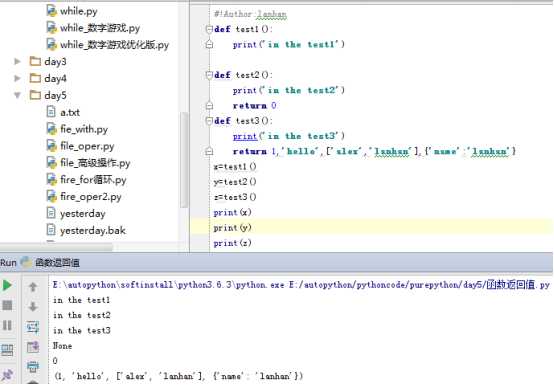
10.3 参数
10.3.1形参与实参
形参:变量只有在被调用时才分配内存单元,在调用结束时,即刻释放所分配的内存单元。因此,形参只在函数内部有效。函数调用结束返回主调用函数后则不能再使用该形参变量
实参:可以是常量、变量、表达式、函数等,无论实参是何种类型的量,在进行函数调用时,它们都必须有确定的值,以便把这些值传送给形参。因此应预先用赋值,输入等办法使参数获得确定值
10.3.2 位置参数与关键字参数
位置参数:给函数传参数要按顺序
关键字参数:不想按顺序就可以用关键参数,只需指定参数名
示例1:
#!Author:lanhan
def test(x,y):
print(x)
print(y)
test(1,2) #位置参数调用(与形参一一对应,实参数需与形参对应,不能多也不能少)
test(y=2,x=1) #关键字调用(与形参顺序无关)
#位置参数和关键字参数混合使用,按照位置参数来传值
#test(x=2,3) #错误(关键参数必须写在位置参数之后,第一个参数是位置参数第二个参数不能是第一个参数值)
test(3,y=2) #正确
#test(3,x=2) #错误

10.3.3默认参数
特点:1.调用函数的时候,默认参数非必须传递
2.若不传递默认参数值,则默认为默认的值。若传递默认参数值,则返回新传递的值
示例1:
#!Author:lanhan
def test(x,y=2):
print(x)
print(y)
test(1,3) #默认参数赋新值,返回最新值
test(1) #默认参数没有赋值,则返回默认参数值
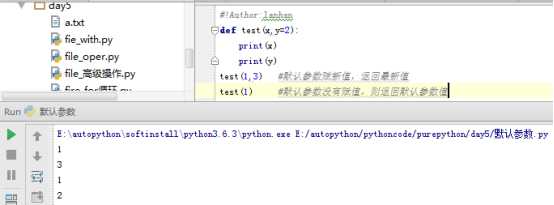
10.3.4非固定参数(参数组)
不确定实参传入多少个参数,形参使用非固定参数
示例1:
#!Author:lanhan
def test(*args):
print(args)
test(1,2,3,4,5,5)
test(*[1,2,3,4,5,5]) #*args=*[1,2,3,4,5,5]

示例2:
#*args:接受N个位置参数,转换成元组形式
def test(*args):
print(args)
test(1,2,3,4,5,5)
test(*[1,2,3,4,5,5]) #*args=*[1,2,3,4,5,5]
示例3:
#**kwargs:把N个关键字参数,转换成字典的方式
def test2(**kwargs):
print(kwargs)
print(kwargs[‘name‘])
print(kwargs[‘age‘])
print(kwargs[‘sex‘])
test2(name=‘lanhan‘,age=8,sex=‘F‘)
test2(**{‘name‘:‘lanhan‘,‘age‘:8,‘sex‘:‘man‘}) #字典传参
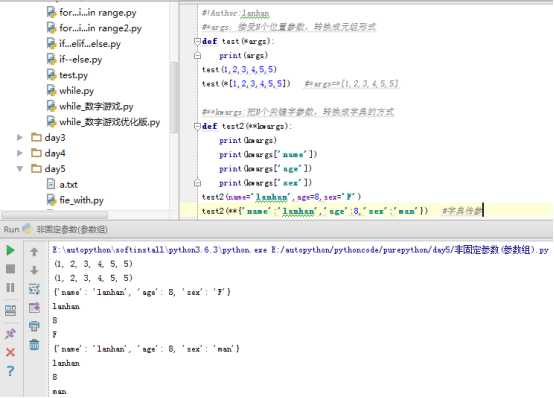
示例4:
def test3(name,**kwargs):
print(name)
print(kwargs)
test3(‘lanhan‘,age=18,sex=‘m‘) #与位置参数、关键字参数结合
示例5:
def test4(name,age=18,**kwargs):
print(name)
print(age)
print(kwargs)
test4(‘lanhan‘,12,sex=‘m‘,hobby=‘tesla‘) #与默认参数结合

10.3.5局部变量
在子程序中定义的变量称为局部变量,在程序的一开始定义的变量称为全局变量。
全局变量作用域是整个程序,局部变量作用域是定义该变量的子程序。
当全局变量与局部变量同名时:
在定义局部变量的子程序内,局部变量起作用;在其它地方全局变量起作用
注:1.若要在子程序内强制更改全局变量,需用global声明
2.全局变量是字典、集合、列表,在局部变量的子程序内可以更改
示例1:
#!Author:lanhan
school = "oldboy edu."
def change_name(name):
global school #声明局部更改全局变量
school = "Mage Linux"
print("before change",name)
name = "Lanhan" #这个函数就是这个变量的作用域
age = 23
print("after change",name,school)
name = ‘lanhan‘
change_name(name)
print("全局变量",name) #
print("school:",school)
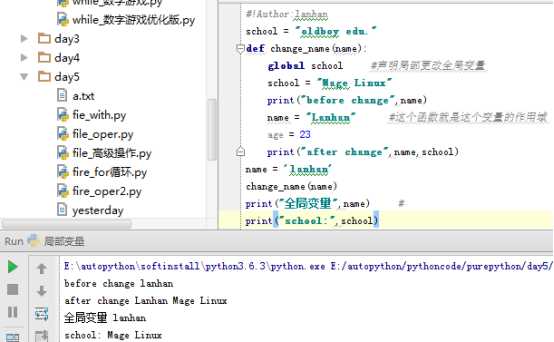
10.4 递归
在函数内部,可以调用其他函数。如果一个函数在内部调用自身本身,这个函数就是递归函数
递归特性:
1. 必须有一个明确的结束条件
2. 每次进入更深一层递归时,问题规模相比上次递归都应有所减少
3. 递归效率不高,递归层次过多会导致栈溢出(在计算机中,函数调用是通过栈(stack)这种数据结构实现的,每当进入一个函数调用,栈就会加一层栈帧,每当函数返回,栈就会减一层栈帧。由于栈的大小不是无限的,所以,递归调用的次数过多,会导致栈溢出)
示例1:
#!Author:lanhan
def calc(n):
print(n)
return calc(n+1)
calc(0)
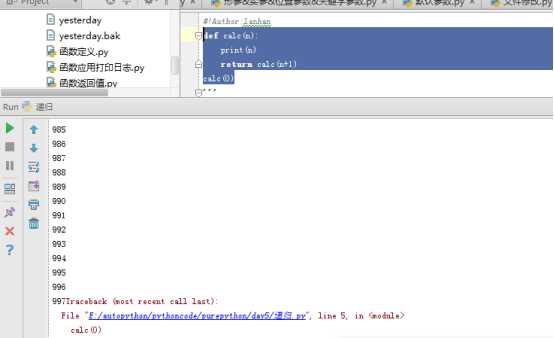
示例2:
def calc(n):
print(n)
if int(n/2) >0:
return calc(int(n/2))
print("-->",n)
calc(10)
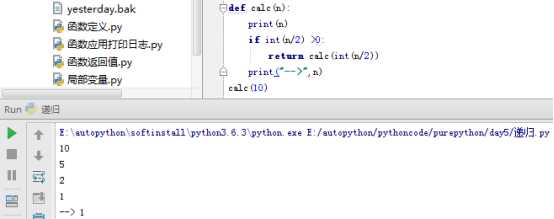
10.5 高阶函数
变量可以指向函数,函数的参数能接收变量,那么一个函数就可以接收另一个函数作为参数,这种函数就称之为高阶函数
示例1:
#!Author:lanhan
def add(a,b,f):
return f(a)+f(b)
res = add(3,-6,abs)
print(res)

10.6 内置函数
标签:第一个 字典 rgs 导致 类型 扩展 实现 font write
原文地址:http://www.cnblogs.com/decorator/p/7898837.html